Analysis of Food Safety Management in Hospitality, HND Unit 31
VerifiedAdded on 2020/10/22
|11
|3609
|428
Report
AI Summary
This report on food safety management delves into crucial aspects of maintaining food safety within the hospitality industry, using Hotel Russell as a case study. It explores food spoilage agents, methods of prevention, and their effectiveness, emphasizing the roles of bacteria, viruses, and fungi. The report details temperature control systems, safe storage methods (including freezing, drying, and canning), and the significance of personal hygiene in preventing contamination. Cleaning, disinfection, and pest control are discussed, along with hygienic design of food premises and the importance of staff training for quality assurance. Furthermore, the report identifies food hazards, outlines the establishment of a food security system, and highlights food safety guidelines for legislative compliance, providing a comprehensive overview of food safety management practices.
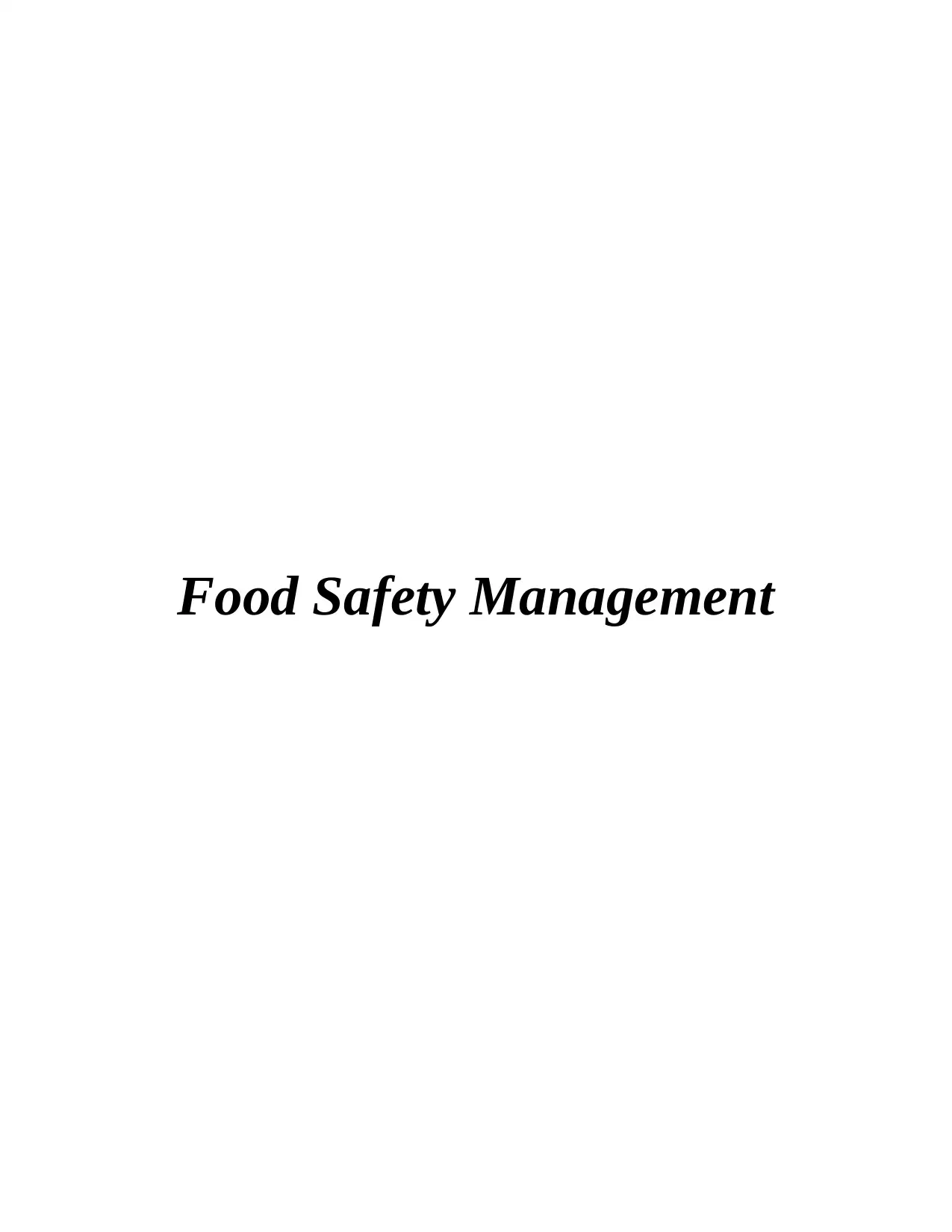
Food Safety Management
Paraphrase This Document
Need a fresh take? Get an instant paraphrase of this document with our AI Paraphraser
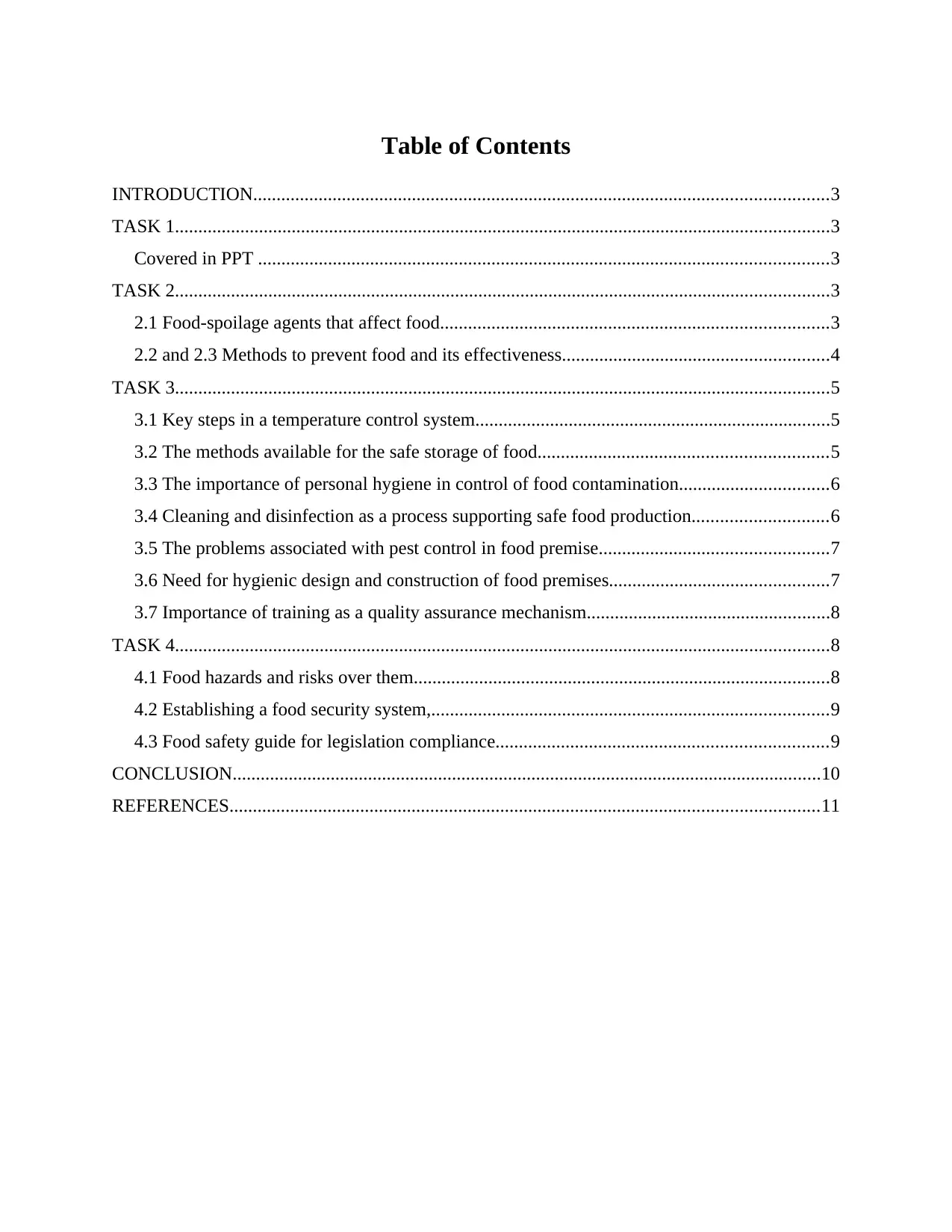
Table of Contents
INTRODUCTION...........................................................................................................................3
TASK 1............................................................................................................................................3
Covered in PPT ..........................................................................................................................3
TASK 2............................................................................................................................................3
2.1 Food-spoilage agents that affect food...................................................................................3
2.2 and 2.3 Methods to prevent food and its effectiveness.........................................................4
TASK 3............................................................................................................................................5
3.1 Key steps in a temperature control system............................................................................5
3.2 The methods available for the safe storage of food..............................................................5
3.3 The importance of personal hygiene in control of food contamination................................6
3.4 Cleaning and disinfection as a process supporting safe food production.............................6
3.5 The problems associated with pest control in food premise.................................................7
3.6 Need for hygienic design and construction of food premises...............................................7
3.7 Importance of training as a quality assurance mechanism....................................................8
TASK 4............................................................................................................................................8
4.1 Food hazards and risks over them.........................................................................................8
4.2 Establishing a food security system,.....................................................................................9
4.3 Food safety guide for legislation compliance.......................................................................9
CONCLUSION..............................................................................................................................10
REFERENCES..............................................................................................................................11
INTRODUCTION...........................................................................................................................3
TASK 1............................................................................................................................................3
Covered in PPT ..........................................................................................................................3
TASK 2............................................................................................................................................3
2.1 Food-spoilage agents that affect food...................................................................................3
2.2 and 2.3 Methods to prevent food and its effectiveness.........................................................4
TASK 3............................................................................................................................................5
3.1 Key steps in a temperature control system............................................................................5
3.2 The methods available for the safe storage of food..............................................................5
3.3 The importance of personal hygiene in control of food contamination................................6
3.4 Cleaning and disinfection as a process supporting safe food production.............................6
3.5 The problems associated with pest control in food premise.................................................7
3.6 Need for hygienic design and construction of food premises...............................................7
3.7 Importance of training as a quality assurance mechanism....................................................8
TASK 4............................................................................................................................................8
4.1 Food hazards and risks over them.........................................................................................8
4.2 Establishing a food security system,.....................................................................................9
4.3 Food safety guide for legislation compliance.......................................................................9
CONCLUSION..............................................................................................................................10
REFERENCES..............................................................................................................................11
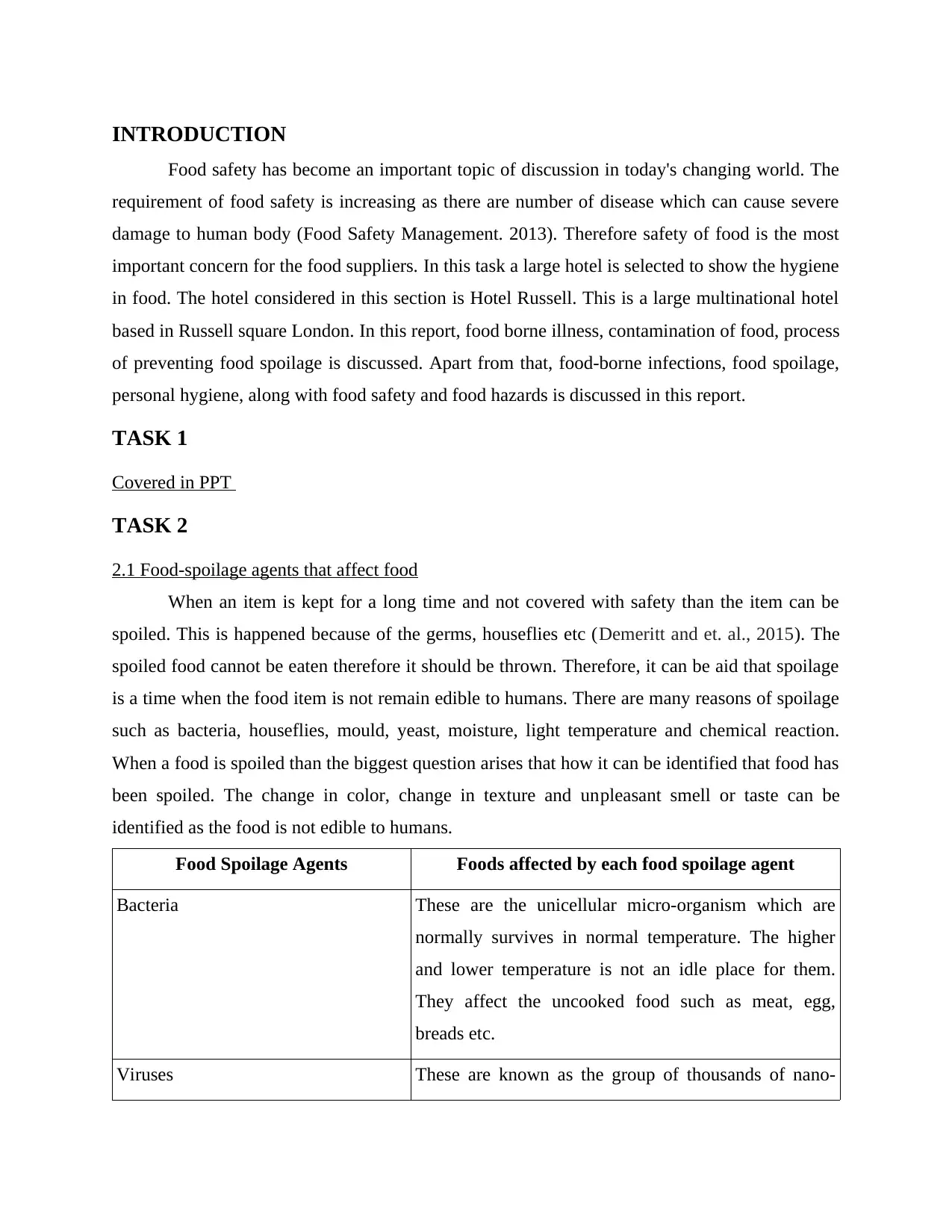
INTRODUCTION
Food safety has become an important topic of discussion in today's changing world. The
requirement of food safety is increasing as there are number of disease which can cause severe
damage to human body (Food Safety Management. 2013). Therefore safety of food is the most
important concern for the food suppliers. In this task a large hotel is selected to show the hygiene
in food. The hotel considered in this section is Hotel Russell. This is a large multinational hotel
based in Russell square London. In this report, food borne illness, contamination of food, process
of preventing food spoilage is discussed. Apart from that, food-borne infections, food spoilage,
personal hygiene, along with food safety and food hazards is discussed in this report.
TASK 1
Covered in PPT
TASK 2
2.1 Food-spoilage agents that affect food
When an item is kept for a long time and not covered with safety than the item can be
spoiled. This is happened because of the germs, houseflies etc (Demeritt and et. al., 2015). The
spoiled food cannot be eaten therefore it should be thrown. Therefore, it can be aid that spoilage
is a time when the food item is not remain edible to humans. There are many reasons of spoilage
such as bacteria, houseflies, mould, yeast, moisture, light temperature and chemical reaction.
When a food is spoiled than the biggest question arises that how it can be identified that food has
been spoiled. The change in color, change in texture and unpleasant smell or taste can be
identified as the food is not edible to humans.
Food Spoilage Agents Foods affected by each food spoilage agent
Bacteria These are the unicellular micro-organism which are
normally survives in normal temperature. The higher
and lower temperature is not an idle place for them.
They affect the uncooked food such as meat, egg,
breads etc.
Viruses These are known as the group of thousands of nano-
Food safety has become an important topic of discussion in today's changing world. The
requirement of food safety is increasing as there are number of disease which can cause severe
damage to human body (Food Safety Management. 2013). Therefore safety of food is the most
important concern for the food suppliers. In this task a large hotel is selected to show the hygiene
in food. The hotel considered in this section is Hotel Russell. This is a large multinational hotel
based in Russell square London. In this report, food borne illness, contamination of food, process
of preventing food spoilage is discussed. Apart from that, food-borne infections, food spoilage,
personal hygiene, along with food safety and food hazards is discussed in this report.
TASK 1
Covered in PPT
TASK 2
2.1 Food-spoilage agents that affect food
When an item is kept for a long time and not covered with safety than the item can be
spoiled. This is happened because of the germs, houseflies etc (Demeritt and et. al., 2015). The
spoiled food cannot be eaten therefore it should be thrown. Therefore, it can be aid that spoilage
is a time when the food item is not remain edible to humans. There are many reasons of spoilage
such as bacteria, houseflies, mould, yeast, moisture, light temperature and chemical reaction.
When a food is spoiled than the biggest question arises that how it can be identified that food has
been spoiled. The change in color, change in texture and unpleasant smell or taste can be
identified as the food is not edible to humans.
Food Spoilage Agents Foods affected by each food spoilage agent
Bacteria These are the unicellular micro-organism which are
normally survives in normal temperature. The higher
and lower temperature is not an idle place for them.
They affect the uncooked food such as meat, egg,
breads etc.
Viruses These are known as the group of thousands of nano-
⊘ This is a preview!⊘
Do you want full access?
Subscribe today to unlock all pages.

Trusted by 1+ million students worldwide
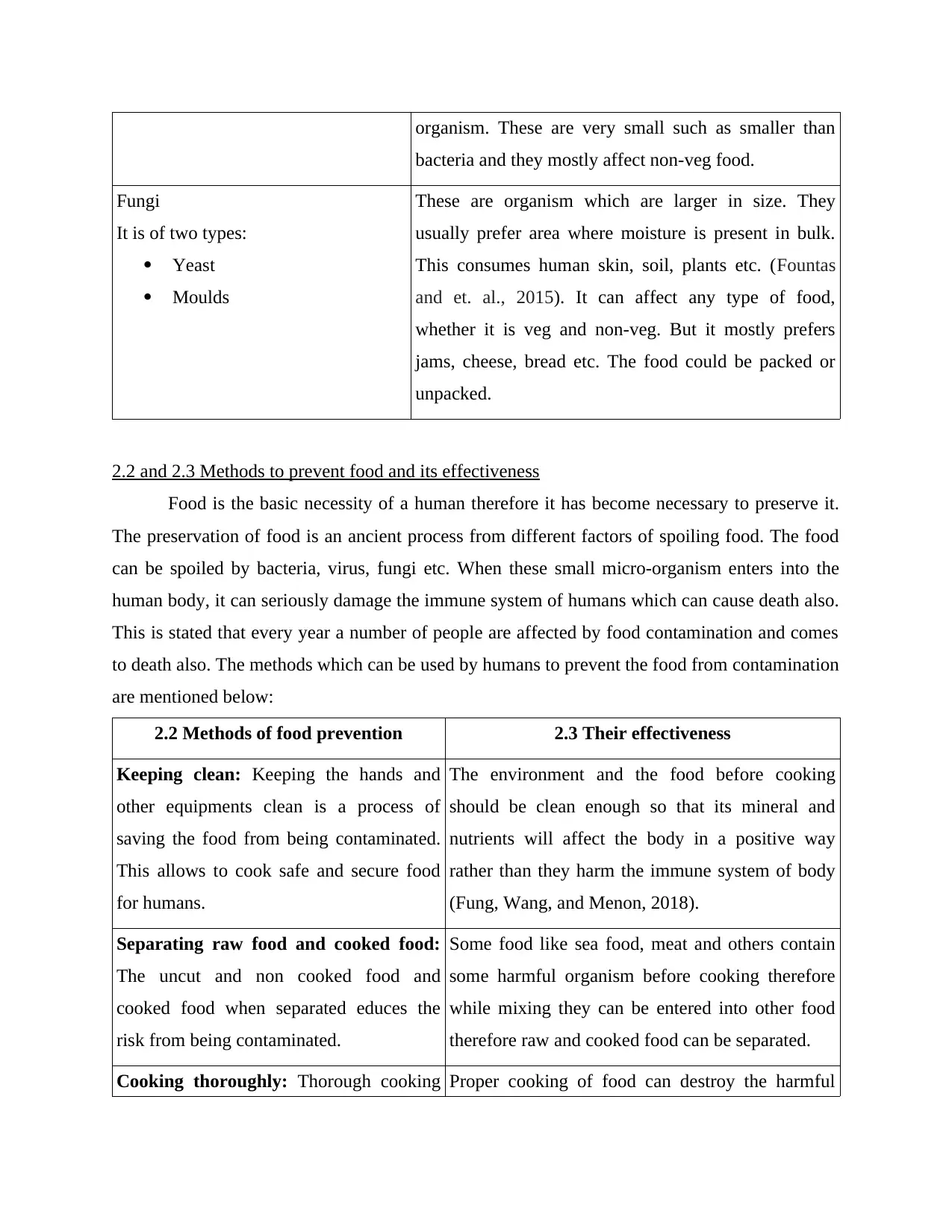
organism. These are very small such as smaller than
bacteria and they mostly affect non-veg food.
Fungi
It is of two types:
Yeast
Moulds
These are organism which are larger in size. They
usually prefer area where moisture is present in bulk.
This consumes human skin, soil, plants etc. (Fountas
and et. al., 2015). It can affect any type of food,
whether it is veg and non-veg. But it mostly prefers
jams, cheese, bread etc. The food could be packed or
unpacked.
2.2 and 2.3 Methods to prevent food and its effectiveness
Food is the basic necessity of a human therefore it has become necessary to preserve it.
The preservation of food is an ancient process from different factors of spoiling food. The food
can be spoiled by bacteria, virus, fungi etc. When these small micro-organism enters into the
human body, it can seriously damage the immune system of humans which can cause death also.
This is stated that every year a number of people are affected by food contamination and comes
to death also. The methods which can be used by humans to prevent the food from contamination
are mentioned below:
2.2 Methods of food prevention 2.3 Their effectiveness
Keeping clean: Keeping the hands and
other equipments clean is a process of
saving the food from being contaminated.
This allows to cook safe and secure food
for humans.
The environment and the food before cooking
should be clean enough so that its mineral and
nutrients will affect the body in a positive way
rather than they harm the immune system of body
(Fung, Wang, and Menon, 2018).
Separating raw food and cooked food:
The uncut and non cooked food and
cooked food when separated educes the
risk from being contaminated.
Some food like sea food, meat and others contain
some harmful organism before cooking therefore
while mixing they can be entered into other food
therefore raw and cooked food can be separated.
Cooking thoroughly: Thorough cooking Proper cooking of food can destroy the harmful
bacteria and they mostly affect non-veg food.
Fungi
It is of two types:
Yeast
Moulds
These are organism which are larger in size. They
usually prefer area where moisture is present in bulk.
This consumes human skin, soil, plants etc. (Fountas
and et. al., 2015). It can affect any type of food,
whether it is veg and non-veg. But it mostly prefers
jams, cheese, bread etc. The food could be packed or
unpacked.
2.2 and 2.3 Methods to prevent food and its effectiveness
Food is the basic necessity of a human therefore it has become necessary to preserve it.
The preservation of food is an ancient process from different factors of spoiling food. The food
can be spoiled by bacteria, virus, fungi etc. When these small micro-organism enters into the
human body, it can seriously damage the immune system of humans which can cause death also.
This is stated that every year a number of people are affected by food contamination and comes
to death also. The methods which can be used by humans to prevent the food from contamination
are mentioned below:
2.2 Methods of food prevention 2.3 Their effectiveness
Keeping clean: Keeping the hands and
other equipments clean is a process of
saving the food from being contaminated.
This allows to cook safe and secure food
for humans.
The environment and the food before cooking
should be clean enough so that its mineral and
nutrients will affect the body in a positive way
rather than they harm the immune system of body
(Fung, Wang, and Menon, 2018).
Separating raw food and cooked food:
The uncut and non cooked food and
cooked food when separated educes the
risk from being contaminated.
Some food like sea food, meat and others contain
some harmful organism before cooking therefore
while mixing they can be entered into other food
therefore raw and cooked food can be separated.
Cooking thoroughly: Thorough cooking Proper cooking of food can destroy the harmful
Paraphrase This Document
Need a fresh take? Get an instant paraphrase of this document with our AI Paraphraser
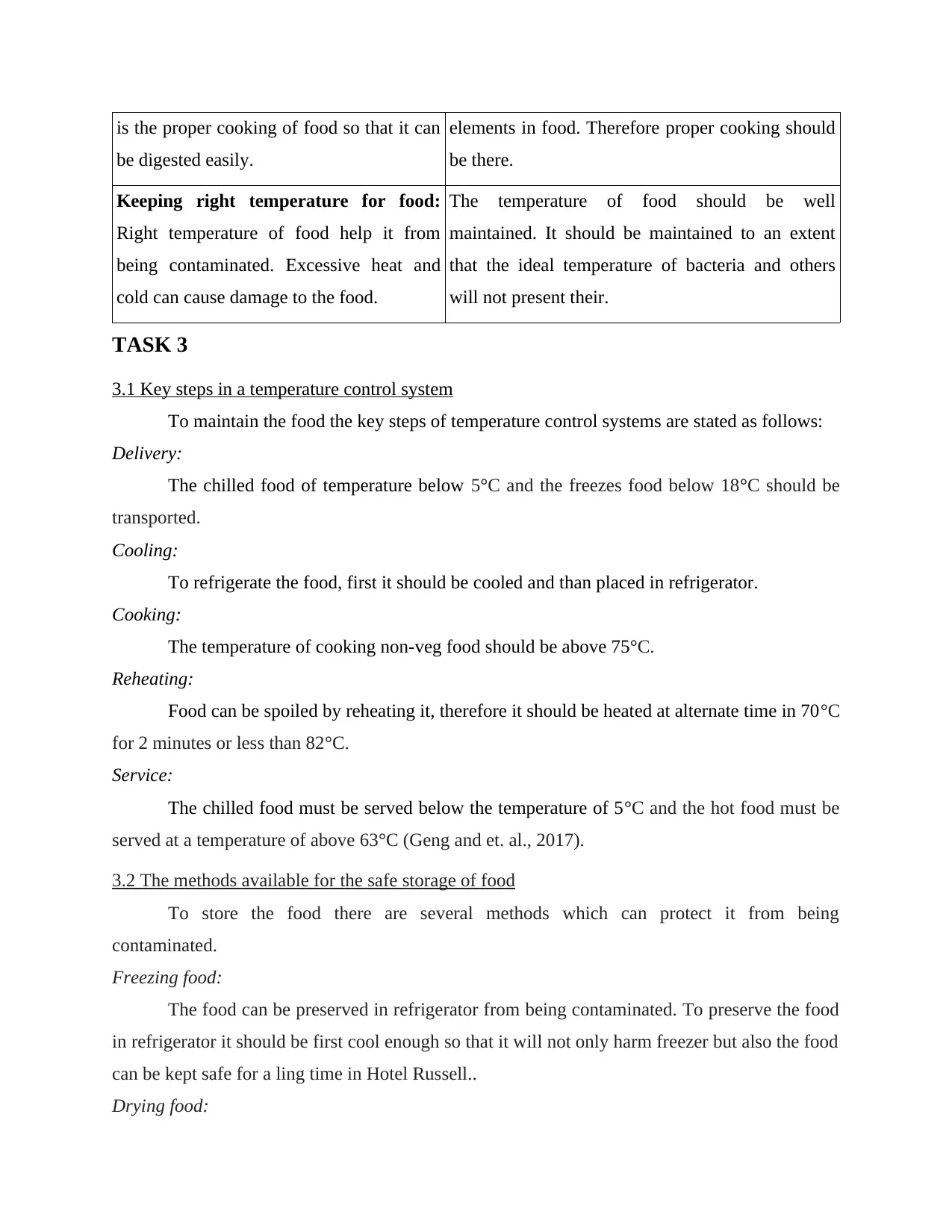
is the proper cooking of food so that it can
be digested easily.
elements in food. Therefore proper cooking should
be there.
Keeping right temperature for food:
Right temperature of food help it from
being contaminated. Excessive heat and
cold can cause damage to the food.
The temperature of food should be well
maintained. It should be maintained to an extent
that the ideal temperature of bacteria and others
will not present their.
TASK 3
3.1 Key steps in a temperature control system
To maintain the food the key steps of temperature control systems are stated as follows:
Delivery:
The chilled food of temperature below 5°C and the freezes food below 18°C should be
transported.
Cooling:
To refrigerate the food, first it should be cooled and than placed in refrigerator.
Cooking:
The temperature of cooking non-veg food should be above 75°C.
Reheating:
Food can be spoiled by reheating it, therefore it should be heated at alternate time in 70°C
for 2 minutes or less than 82°C.
Service:
The chilled food must be served below the temperature of 5°C and the hot food must be
served at a temperature of above 63°C (Geng and et. al., 2017).
3.2 The methods available for the safe storage of food
To store the food there are several methods which can protect it from being
contaminated.
Freezing food:
The food can be preserved in refrigerator from being contaminated. To preserve the food
in refrigerator it should be first cool enough so that it will not only harm freezer but also the food
can be kept safe for a ling time in Hotel Russell..
Drying food:
be digested easily.
elements in food. Therefore proper cooking should
be there.
Keeping right temperature for food:
Right temperature of food help it from
being contaminated. Excessive heat and
cold can cause damage to the food.
The temperature of food should be well
maintained. It should be maintained to an extent
that the ideal temperature of bacteria and others
will not present their.
TASK 3
3.1 Key steps in a temperature control system
To maintain the food the key steps of temperature control systems are stated as follows:
Delivery:
The chilled food of temperature below 5°C and the freezes food below 18°C should be
transported.
Cooling:
To refrigerate the food, first it should be cooled and than placed in refrigerator.
Cooking:
The temperature of cooking non-veg food should be above 75°C.
Reheating:
Food can be spoiled by reheating it, therefore it should be heated at alternate time in 70°C
for 2 minutes or less than 82°C.
Service:
The chilled food must be served below the temperature of 5°C and the hot food must be
served at a temperature of above 63°C (Geng and et. al., 2017).
3.2 The methods available for the safe storage of food
To store the food there are several methods which can protect it from being
contaminated.
Freezing food:
The food can be preserved in refrigerator from being contaminated. To preserve the food
in refrigerator it should be first cool enough so that it will not only harm freezer but also the food
can be kept safe for a ling time in Hotel Russell..
Drying food:
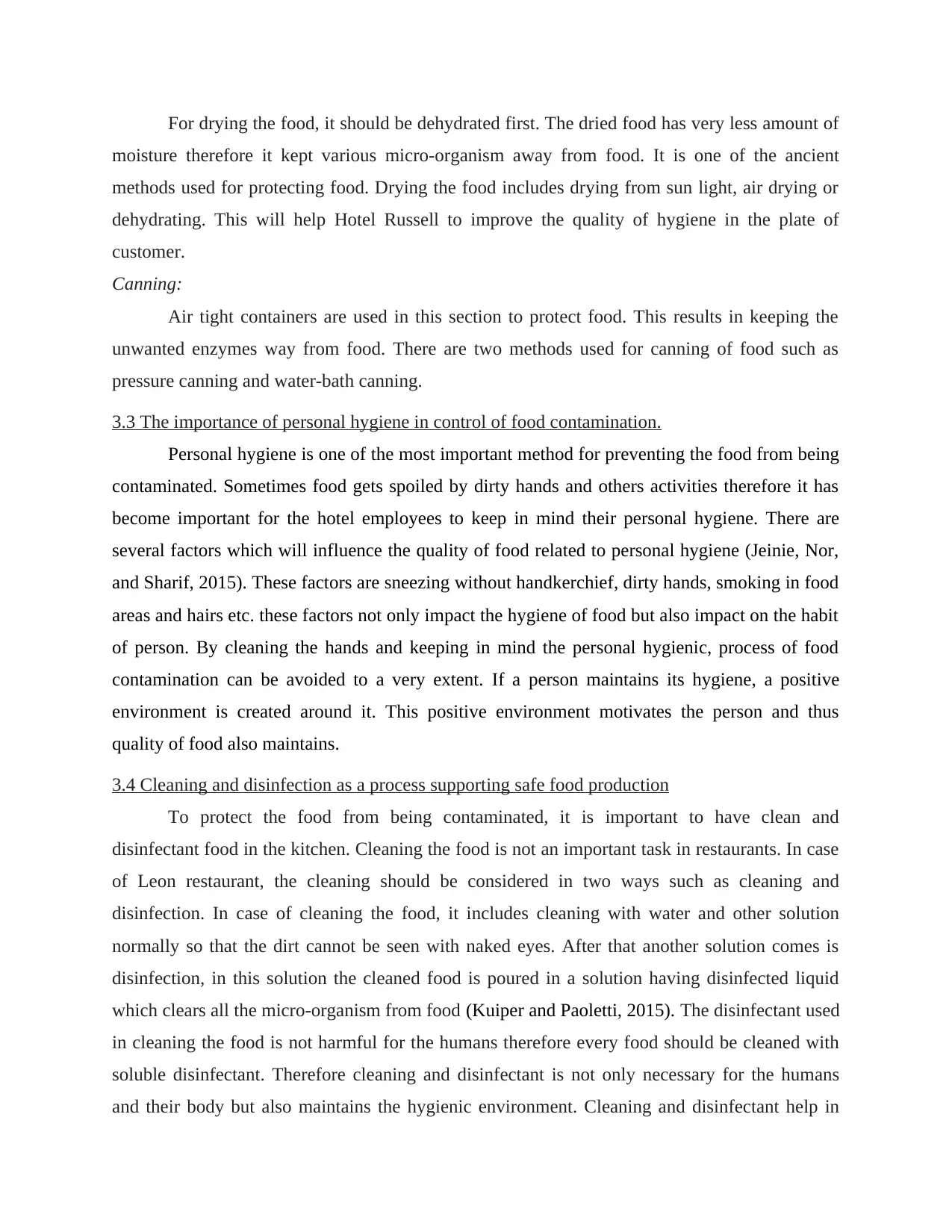
For drying the food, it should be dehydrated first. The dried food has very less amount of
moisture therefore it kept various micro-organism away from food. It is one of the ancient
methods used for protecting food. Drying the food includes drying from sun light, air drying or
dehydrating. This will help Hotel Russell to improve the quality of hygiene in the plate of
customer.
Canning:
Air tight containers are used in this section to protect food. This results in keeping the
unwanted enzymes way from food. There are two methods used for canning of food such as
pressure canning and water-bath canning.
3.3 The importance of personal hygiene in control of food contamination.
Personal hygiene is one of the most important method for preventing the food from being
contaminated. Sometimes food gets spoiled by dirty hands and others activities therefore it has
become important for the hotel employees to keep in mind their personal hygiene. There are
several factors which will influence the quality of food related to personal hygiene (Jeinie, Nor,
and Sharif, 2015). These factors are sneezing without handkerchief, dirty hands, smoking in food
areas and hairs etc. these factors not only impact the hygiene of food but also impact on the habit
of person. By cleaning the hands and keeping in mind the personal hygienic, process of food
contamination can be avoided to a very extent. If a person maintains its hygiene, a positive
environment is created around it. This positive environment motivates the person and thus
quality of food also maintains.
3.4 Cleaning and disinfection as a process supporting safe food production
To protect the food from being contaminated, it is important to have clean and
disinfectant food in the kitchen. Cleaning the food is not an important task in restaurants. In case
of Leon restaurant, the cleaning should be considered in two ways such as cleaning and
disinfection. In case of cleaning the food, it includes cleaning with water and other solution
normally so that the dirt cannot be seen with naked eyes. After that another solution comes is
disinfection, in this solution the cleaned food is poured in a solution having disinfected liquid
which clears all the micro-organism from food (Kuiper and Paoletti, 2015). The disinfectant used
in cleaning the food is not harmful for the humans therefore every food should be cleaned with
soluble disinfectant. Therefore cleaning and disinfectant is not only necessary for the humans
and their body but also maintains the hygienic environment. Cleaning and disinfectant help in
moisture therefore it kept various micro-organism away from food. It is one of the ancient
methods used for protecting food. Drying the food includes drying from sun light, air drying or
dehydrating. This will help Hotel Russell to improve the quality of hygiene in the plate of
customer.
Canning:
Air tight containers are used in this section to protect food. This results in keeping the
unwanted enzymes way from food. There are two methods used for canning of food such as
pressure canning and water-bath canning.
3.3 The importance of personal hygiene in control of food contamination.
Personal hygiene is one of the most important method for preventing the food from being
contaminated. Sometimes food gets spoiled by dirty hands and others activities therefore it has
become important for the hotel employees to keep in mind their personal hygiene. There are
several factors which will influence the quality of food related to personal hygiene (Jeinie, Nor,
and Sharif, 2015). These factors are sneezing without handkerchief, dirty hands, smoking in food
areas and hairs etc. these factors not only impact the hygiene of food but also impact on the habit
of person. By cleaning the hands and keeping in mind the personal hygienic, process of food
contamination can be avoided to a very extent. If a person maintains its hygiene, a positive
environment is created around it. This positive environment motivates the person and thus
quality of food also maintains.
3.4 Cleaning and disinfection as a process supporting safe food production
To protect the food from being contaminated, it is important to have clean and
disinfectant food in the kitchen. Cleaning the food is not an important task in restaurants. In case
of Leon restaurant, the cleaning should be considered in two ways such as cleaning and
disinfection. In case of cleaning the food, it includes cleaning with water and other solution
normally so that the dirt cannot be seen with naked eyes. After that another solution comes is
disinfection, in this solution the cleaned food is poured in a solution having disinfected liquid
which clears all the micro-organism from food (Kuiper and Paoletti, 2015). The disinfectant used
in cleaning the food is not harmful for the humans therefore every food should be cleaned with
soluble disinfectant. Therefore cleaning and disinfectant is not only necessary for the humans
and their body but also maintains the hygienic environment. Cleaning and disinfectant help in
⊘ This is a preview!⊘
Do you want full access?
Subscribe today to unlock all pages.

Trusted by 1+ million students worldwide
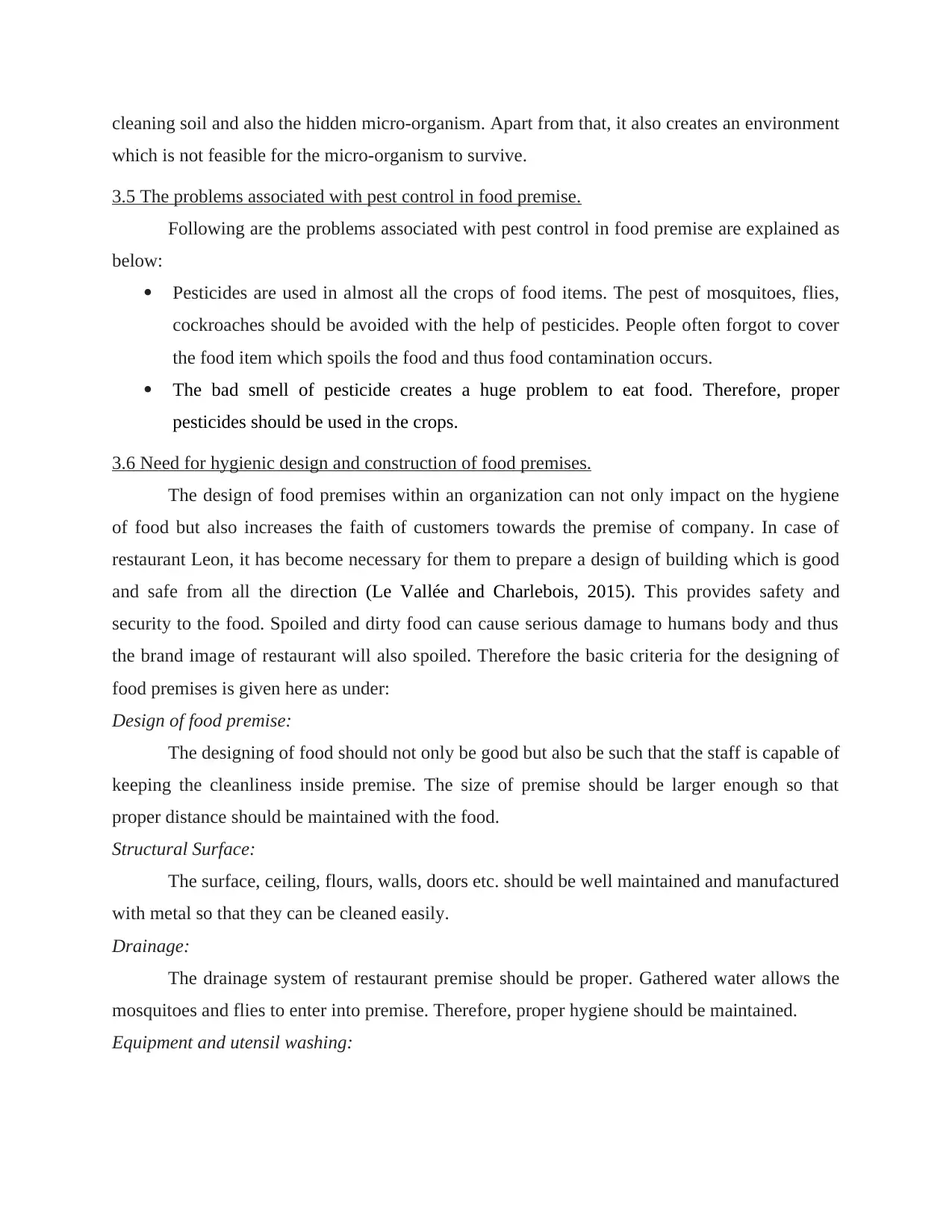
cleaning soil and also the hidden micro-organism. Apart from that, it also creates an environment
which is not feasible for the micro-organism to survive.
3.5 The problems associated with pest control in food premise.
Following are the problems associated with pest control in food premise are explained as
below:
Pesticides are used in almost all the crops of food items. The pest of mosquitoes, flies,
cockroaches should be avoided with the help of pesticides. People often forgot to cover
the food item which spoils the food and thus food contamination occurs.
The bad smell of pesticide creates a huge problem to eat food. Therefore, proper
pesticides should be used in the crops.
3.6 Need for hygienic design and construction of food premises.
The design of food premises within an organization can not only impact on the hygiene
of food but also increases the faith of customers towards the premise of company. In case of
restaurant Leon, it has become necessary for them to prepare a design of building which is good
and safe from all the direction (Le Vallée and Charlebois, 2015). This provides safety and
security to the food. Spoiled and dirty food can cause serious damage to humans body and thus
the brand image of restaurant will also spoiled. Therefore the basic criteria for the designing of
food premises is given here as under:
Design of food premise:
The designing of food should not only be good but also be such that the staff is capable of
keeping the cleanliness inside premise. The size of premise should be larger enough so that
proper distance should be maintained with the food.
Structural Surface:
The surface, ceiling, flours, walls, doors etc. should be well maintained and manufactured
with metal so that they can be cleaned easily.
Drainage:
The drainage system of restaurant premise should be proper. Gathered water allows the
mosquitoes and flies to enter into premise. Therefore, proper hygiene should be maintained.
Equipment and utensil washing:
which is not feasible for the micro-organism to survive.
3.5 The problems associated with pest control in food premise.
Following are the problems associated with pest control in food premise are explained as
below:
Pesticides are used in almost all the crops of food items. The pest of mosquitoes, flies,
cockroaches should be avoided with the help of pesticides. People often forgot to cover
the food item which spoils the food and thus food contamination occurs.
The bad smell of pesticide creates a huge problem to eat food. Therefore, proper
pesticides should be used in the crops.
3.6 Need for hygienic design and construction of food premises.
The design of food premises within an organization can not only impact on the hygiene
of food but also increases the faith of customers towards the premise of company. In case of
restaurant Leon, it has become necessary for them to prepare a design of building which is good
and safe from all the direction (Le Vallée and Charlebois, 2015). This provides safety and
security to the food. Spoiled and dirty food can cause serious damage to humans body and thus
the brand image of restaurant will also spoiled. Therefore the basic criteria for the designing of
food premises is given here as under:
Design of food premise:
The designing of food should not only be good but also be such that the staff is capable of
keeping the cleanliness inside premise. The size of premise should be larger enough so that
proper distance should be maintained with the food.
Structural Surface:
The surface, ceiling, flours, walls, doors etc. should be well maintained and manufactured
with metal so that they can be cleaned easily.
Drainage:
The drainage system of restaurant premise should be proper. Gathered water allows the
mosquitoes and flies to enter into premise. Therefore, proper hygiene should be maintained.
Equipment and utensil washing:
Paraphrase This Document
Need a fresh take? Get an instant paraphrase of this document with our AI Paraphraser
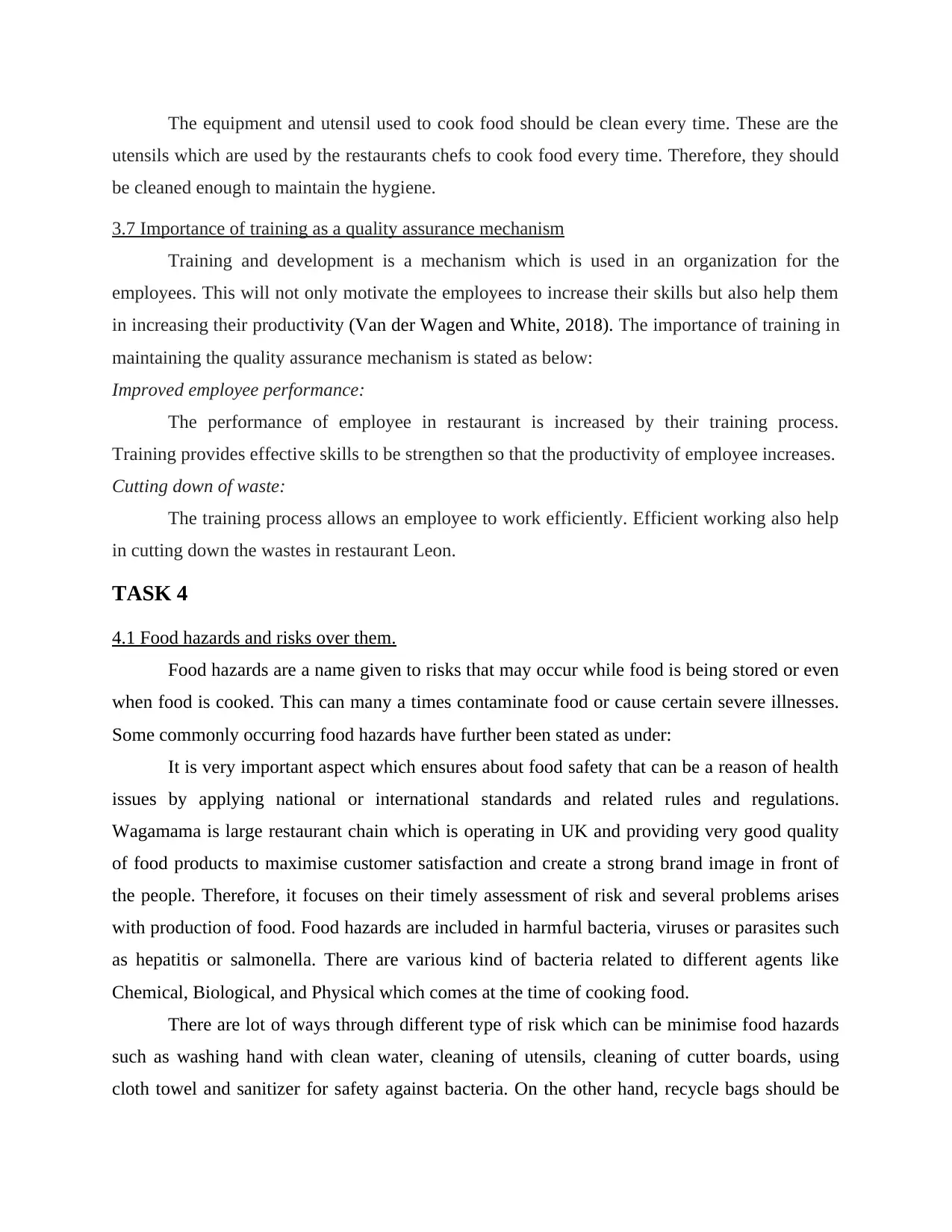
The equipment and utensil used to cook food should be clean every time. These are the
utensils which are used by the restaurants chefs to cook food every time. Therefore, they should
be cleaned enough to maintain the hygiene.
3.7 Importance of training as a quality assurance mechanism
Training and development is a mechanism which is used in an organization for the
employees. This will not only motivate the employees to increase their skills but also help them
in increasing their productivity (Van der Wagen and White, 2018). The importance of training in
maintaining the quality assurance mechanism is stated as below:
Improved employee performance:
The performance of employee in restaurant is increased by their training process.
Training provides effective skills to be strengthen so that the productivity of employee increases.
Cutting down of waste:
The training process allows an employee to work efficiently. Efficient working also help
in cutting down the wastes in restaurant Leon.
TASK 4
4.1 Food hazards and risks over them.
Food hazards are a name given to risks that may occur while food is being stored or even
when food is cooked. This can many a times contaminate food or cause certain severe illnesses.
Some commonly occurring food hazards have further been stated as under:
It is very important aspect which ensures about food safety that can be a reason of health
issues by applying national or international standards and related rules and regulations.
Wagamama is large restaurant chain which is operating in UK and providing very good quality
of food products to maximise customer satisfaction and create a strong brand image in front of
the people. Therefore, it focuses on their timely assessment of risk and several problems arises
with production of food. Food hazards are included in harmful bacteria, viruses or parasites such
as hepatitis or salmonella. There are various kind of bacteria related to different agents like
Chemical, Biological, and Physical which comes at the time of cooking food.
There are lot of ways through different type of risk which can be minimise food hazards
such as washing hand with clean water, cleaning of utensils, cleaning of cutter boards, using
cloth towel and sanitizer for safety against bacteria. On the other hand, recycle bags should be
utensils which are used by the restaurants chefs to cook food every time. Therefore, they should
be cleaned enough to maintain the hygiene.
3.7 Importance of training as a quality assurance mechanism
Training and development is a mechanism which is used in an organization for the
employees. This will not only motivate the employees to increase their skills but also help them
in increasing their productivity (Van der Wagen and White, 2018). The importance of training in
maintaining the quality assurance mechanism is stated as below:
Improved employee performance:
The performance of employee in restaurant is increased by their training process.
Training provides effective skills to be strengthen so that the productivity of employee increases.
Cutting down of waste:
The training process allows an employee to work efficiently. Efficient working also help
in cutting down the wastes in restaurant Leon.
TASK 4
4.1 Food hazards and risks over them.
Food hazards are a name given to risks that may occur while food is being stored or even
when food is cooked. This can many a times contaminate food or cause certain severe illnesses.
Some commonly occurring food hazards have further been stated as under:
It is very important aspect which ensures about food safety that can be a reason of health
issues by applying national or international standards and related rules and regulations.
Wagamama is large restaurant chain which is operating in UK and providing very good quality
of food products to maximise customer satisfaction and create a strong brand image in front of
the people. Therefore, it focuses on their timely assessment of risk and several problems arises
with production of food. Food hazards are included in harmful bacteria, viruses or parasites such
as hepatitis or salmonella. There are various kind of bacteria related to different agents like
Chemical, Biological, and Physical which comes at the time of cooking food.
There are lot of ways through different type of risk which can be minimise food hazards
such as washing hand with clean water, cleaning of utensils, cleaning of cutter boards, using
cloth towel and sanitizer for safety against bacteria. On the other hand, recycle bags should be
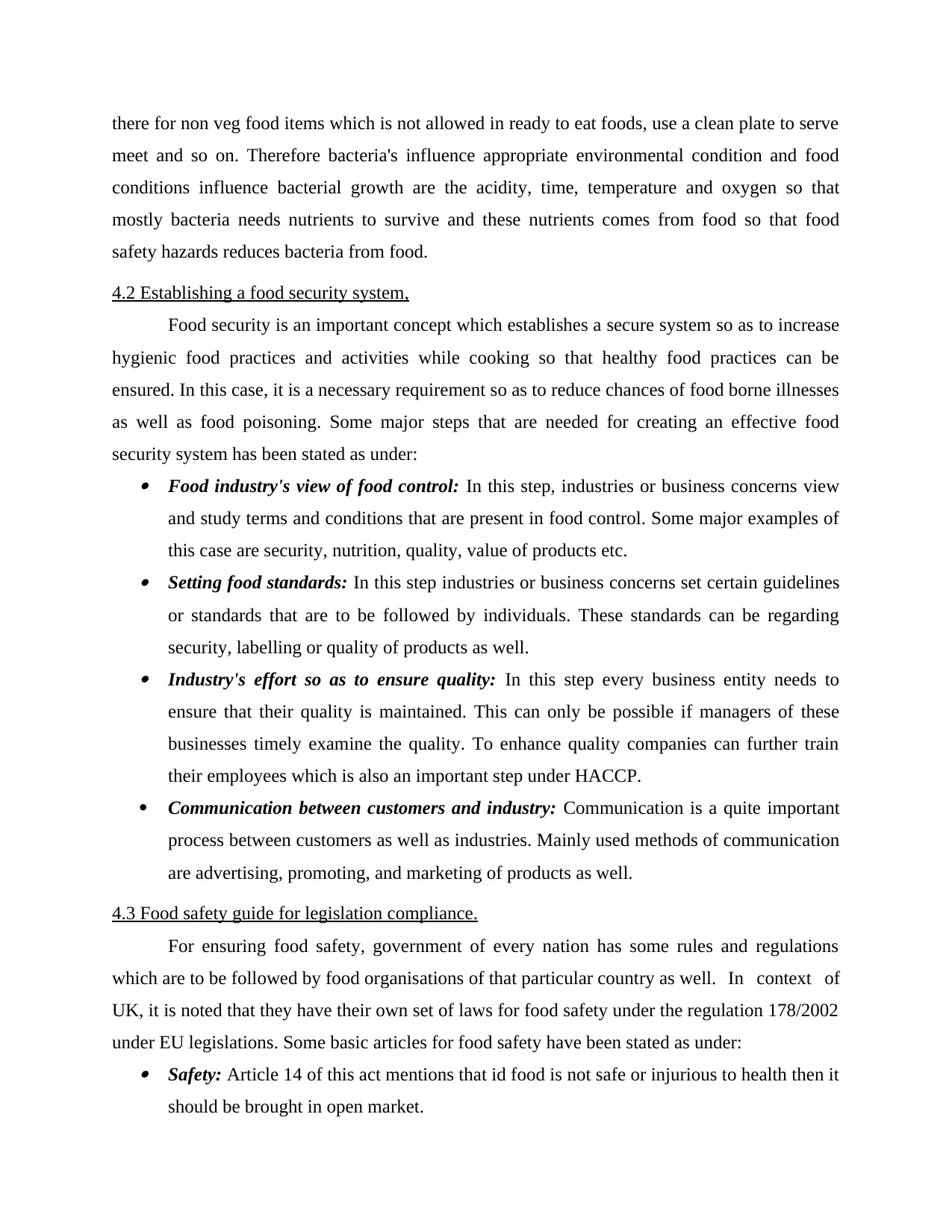
there for non veg food items which is not allowed in ready to eat foods, use a clean plate to serve
meet and so on. Therefore bacteria's influence appropriate environmental condition and food
conditions influence bacterial growth are the acidity, time, temperature and oxygen so that
mostly bacteria needs nutrients to survive and these nutrients comes from food so that food
safety hazards reduces bacteria from food.
4.2 Establishing a food security system,
Food security is an important concept which establishes a secure system so as to increase
hygienic food practices and activities while cooking so that healthy food practices can be
ensured. In this case, it is a necessary requirement so as to reduce chances of food borne illnesses
as well as food poisoning. Some major steps that are needed for creating an effective food
security system has been stated as under: Food industry's view of food control: In this step, industries or business concerns view
and study terms and conditions that are present in food control. Some major examples of
this case are security, nutrition, quality, value of products etc. Setting food standards: In this step industries or business concerns set certain guidelines
or standards that are to be followed by individuals. These standards can be regarding
security, labelling or quality of products as well. Industry's effort so as to ensure quality: In this step every business entity needs to
ensure that their quality is maintained. This can only be possible if managers of these
businesses timely examine the quality. To enhance quality companies can further train
their employees which is also an important step under HACCP.
Communication between customers and industry: Communication is a quite important
process between customers as well as industries. Mainly used methods of communication
are advertising, promoting, and marketing of products as well.
4.3 Food safety guide for legislation compliance.
For ensuring food safety, government of every nation has some rules and regulations
which are to be followed by food organisations of that particular country as well. In context of
UK, it is noted that they have their own set of laws for food safety under the regulation 178/2002
under EU legislations. Some basic articles for food safety have been stated as under: Safety: Article 14 of this act mentions that id food is not safe or injurious to health then it
should be brought in open market.
meet and so on. Therefore bacteria's influence appropriate environmental condition and food
conditions influence bacterial growth are the acidity, time, temperature and oxygen so that
mostly bacteria needs nutrients to survive and these nutrients comes from food so that food
safety hazards reduces bacteria from food.
4.2 Establishing a food security system,
Food security is an important concept which establishes a secure system so as to increase
hygienic food practices and activities while cooking so that healthy food practices can be
ensured. In this case, it is a necessary requirement so as to reduce chances of food borne illnesses
as well as food poisoning. Some major steps that are needed for creating an effective food
security system has been stated as under: Food industry's view of food control: In this step, industries or business concerns view
and study terms and conditions that are present in food control. Some major examples of
this case are security, nutrition, quality, value of products etc. Setting food standards: In this step industries or business concerns set certain guidelines
or standards that are to be followed by individuals. These standards can be regarding
security, labelling or quality of products as well. Industry's effort so as to ensure quality: In this step every business entity needs to
ensure that their quality is maintained. This can only be possible if managers of these
businesses timely examine the quality. To enhance quality companies can further train
their employees which is also an important step under HACCP.
Communication between customers and industry: Communication is a quite important
process between customers as well as industries. Mainly used methods of communication
are advertising, promoting, and marketing of products as well.
4.3 Food safety guide for legislation compliance.
For ensuring food safety, government of every nation has some rules and regulations
which are to be followed by food organisations of that particular country as well. In context of
UK, it is noted that they have their own set of laws for food safety under the regulation 178/2002
under EU legislations. Some basic articles for food safety have been stated as under: Safety: Article 14 of this act mentions that id food is not safe or injurious to health then it
should be brought in open market.
⊘ This is a preview!⊘
Do you want full access?
Subscribe today to unlock all pages.

Trusted by 1+ million students worldwide
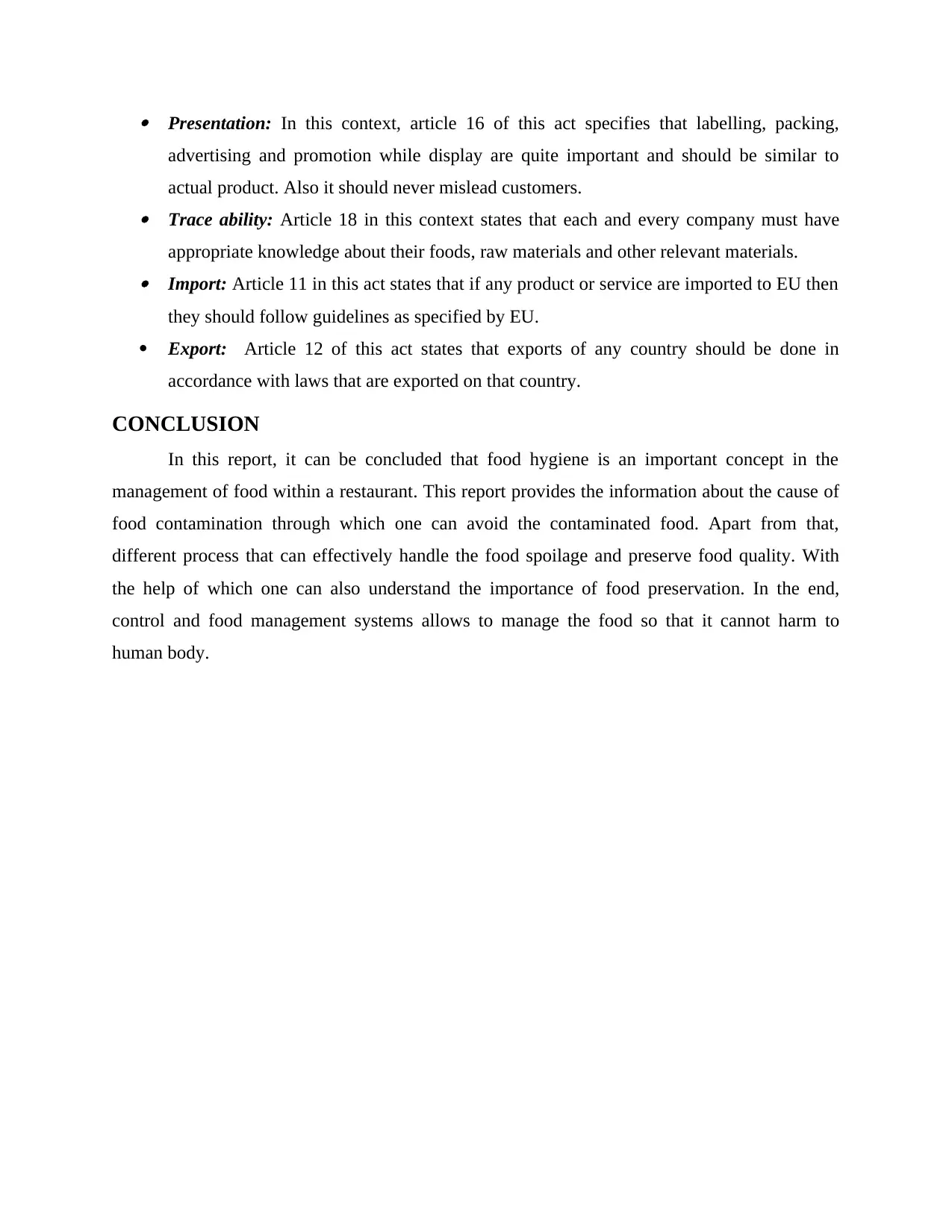
Presentation: In this context, article 16 of this act specifies that labelling, packing,
advertising and promotion while display are quite important and should be similar to
actual product. Also it should never mislead customers. Trace ability: Article 18 in this context states that each and every company must have
appropriate knowledge about their foods, raw materials and other relevant materials. Import: Article 11 in this act states that if any product or service are imported to EU then
they should follow guidelines as specified by EU.
Export: Article 12 of this act states that exports of any country should be done in
accordance with laws that are exported on that country.
CONCLUSION
In this report, it can be concluded that food hygiene is an important concept in the
management of food within a restaurant. This report provides the information about the cause of
food contamination through which one can avoid the contaminated food. Apart from that,
different process that can effectively handle the food spoilage and preserve food quality. With
the help of which one can also understand the importance of food preservation. In the end,
control and food management systems allows to manage the food so that it cannot harm to
human body.
advertising and promotion while display are quite important and should be similar to
actual product. Also it should never mislead customers. Trace ability: Article 18 in this context states that each and every company must have
appropriate knowledge about their foods, raw materials and other relevant materials. Import: Article 11 in this act states that if any product or service are imported to EU then
they should follow guidelines as specified by EU.
Export: Article 12 of this act states that exports of any country should be done in
accordance with laws that are exported on that country.
CONCLUSION
In this report, it can be concluded that food hygiene is an important concept in the
management of food within a restaurant. This report provides the information about the cause of
food contamination through which one can avoid the contaminated food. Apart from that,
different process that can effectively handle the food spoilage and preserve food quality. With
the help of which one can also understand the importance of food preservation. In the end,
control and food management systems allows to manage the food so that it cannot harm to
human body.
Paraphrase This Document
Need a fresh take? Get an instant paraphrase of this document with our AI Paraphraser
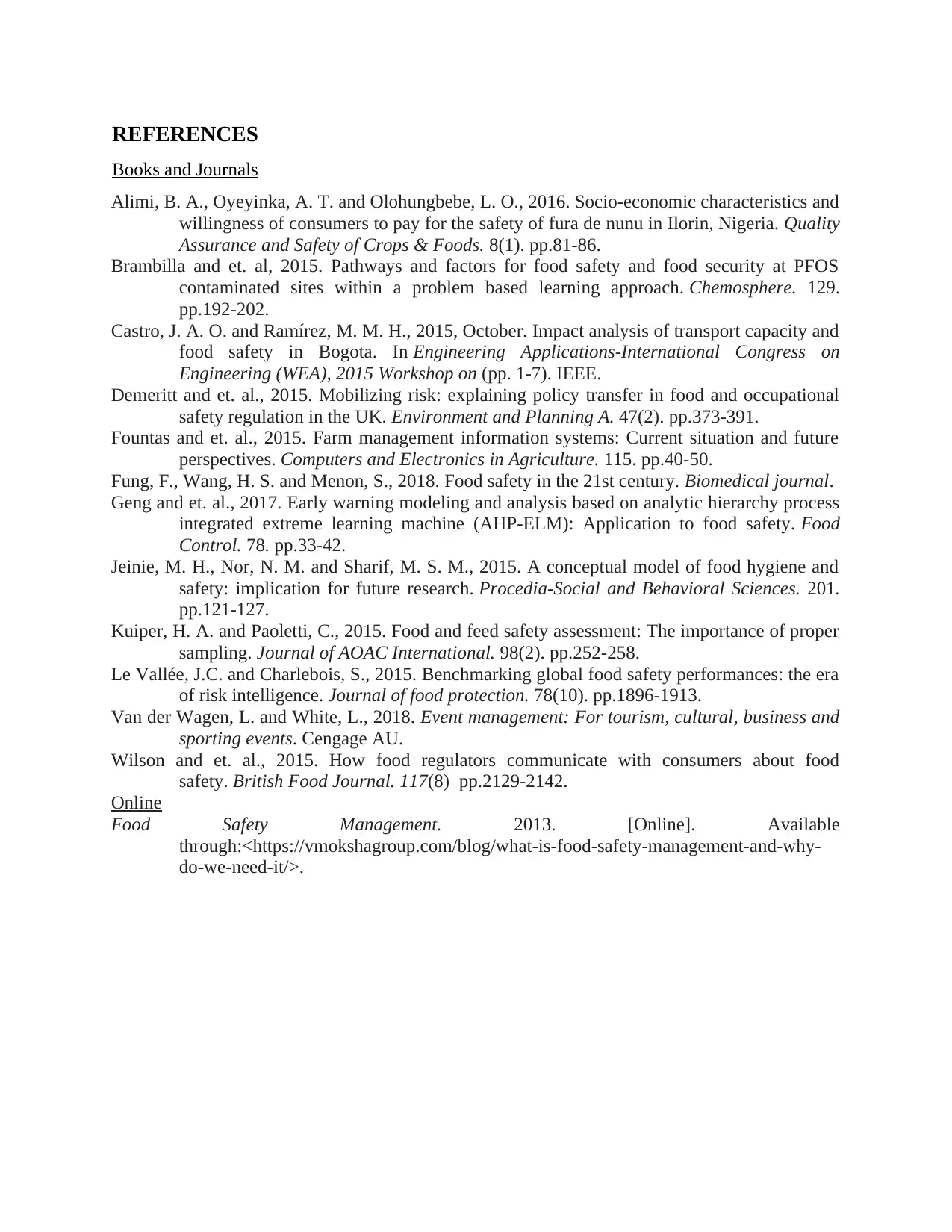
REFERENCES
Books and Journals
Alimi, B. A., Oyeyinka, A. T. and Olohungbebe, L. O., 2016. Socio-economic characteristics and
willingness of consumers to pay for the safety of fura de nunu in Ilorin, Nigeria. Quality
Assurance and Safety of Crops & Foods. 8(1). pp.81-86.
Brambilla and et. al, 2015. Pathways and factors for food safety and food security at PFOS
contaminated sites within a problem based learning approach. Chemosphere. 129.
pp.192-202.
Castro, J. A. O. and Ramírez, M. M. H., 2015, October. Impact analysis of transport capacity and
food safety in Bogota. In Engineering Applications-International Congress on
Engineering (WEA), 2015 Workshop on (pp. 1-7). IEEE.
Demeritt and et. al., 2015. Mobilizing risk: explaining policy transfer in food and occupational
safety regulation in the UK. Environment and Planning A. 47(2). pp.373-391.
Fountas and et. al., 2015. Farm management information systems: Current situation and future
perspectives. Computers and Electronics in Agriculture. 115. pp.40-50.
Fung, F., Wang, H. S. and Menon, S., 2018. Food safety in the 21st century. Biomedical journal.
Geng and et. al., 2017. Early warning modeling and analysis based on analytic hierarchy process
integrated extreme learning machine (AHP-ELM): Application to food safety. Food
Control. 78. pp.33-42.
Jeinie, M. H., Nor, N. M. and Sharif, M. S. M., 2015. A conceptual model of food hygiene and
safety: implication for future research. Procedia-Social and Behavioral Sciences. 201.
pp.121-127.
Kuiper, H. A. and Paoletti, C., 2015. Food and feed safety assessment: The importance of proper
sampling. Journal of AOAC International. 98(2). pp.252-258.
Le Vallée, J.C. and Charlebois, S., 2015. Benchmarking global food safety performances: the era
of risk intelligence. Journal of food protection. 78(10). pp.1896-1913.
Van der Wagen, L. and White, L., 2018. Event management: For tourism, cultural, business and
sporting events. Cengage AU.
Wilson and et. al., 2015. How food regulators communicate with consumers about food
safety. British Food Journal. 117(8) pp.2129-2142.
Online
Food Safety Management. 2013. [Online]. Available
through:<https://vmokshagroup.com/blog/what-is-food-safety-management-and-why-
do-we-need-it/>.
Books and Journals
Alimi, B. A., Oyeyinka, A. T. and Olohungbebe, L. O., 2016. Socio-economic characteristics and
willingness of consumers to pay for the safety of fura de nunu in Ilorin, Nigeria. Quality
Assurance and Safety of Crops & Foods. 8(1). pp.81-86.
Brambilla and et. al, 2015. Pathways and factors for food safety and food security at PFOS
contaminated sites within a problem based learning approach. Chemosphere. 129.
pp.192-202.
Castro, J. A. O. and Ramírez, M. M. H., 2015, October. Impact analysis of transport capacity and
food safety in Bogota. In Engineering Applications-International Congress on
Engineering (WEA), 2015 Workshop on (pp. 1-7). IEEE.
Demeritt and et. al., 2015. Mobilizing risk: explaining policy transfer in food and occupational
safety regulation in the UK. Environment and Planning A. 47(2). pp.373-391.
Fountas and et. al., 2015. Farm management information systems: Current situation and future
perspectives. Computers and Electronics in Agriculture. 115. pp.40-50.
Fung, F., Wang, H. S. and Menon, S., 2018. Food safety in the 21st century. Biomedical journal.
Geng and et. al., 2017. Early warning modeling and analysis based on analytic hierarchy process
integrated extreme learning machine (AHP-ELM): Application to food safety. Food
Control. 78. pp.33-42.
Jeinie, M. H., Nor, N. M. and Sharif, M. S. M., 2015. A conceptual model of food hygiene and
safety: implication for future research. Procedia-Social and Behavioral Sciences. 201.
pp.121-127.
Kuiper, H. A. and Paoletti, C., 2015. Food and feed safety assessment: The importance of proper
sampling. Journal of AOAC International. 98(2). pp.252-258.
Le Vallée, J.C. and Charlebois, S., 2015. Benchmarking global food safety performances: the era
of risk intelligence. Journal of food protection. 78(10). pp.1896-1913.
Van der Wagen, L. and White, L., 2018. Event management: For tourism, cultural, business and
sporting events. Cengage AU.
Wilson and et. al., 2015. How food regulators communicate with consumers about food
safety. British Food Journal. 117(8) pp.2129-2142.
Online
Food Safety Management. 2013. [Online]. Available
through:<https://vmokshagroup.com/blog/what-is-food-safety-management-and-why-
do-we-need-it/>.
1 out of 11
Related Documents
Your All-in-One AI-Powered Toolkit for Academic Success.
+13062052269
info@desklib.com
Available 24*7 on WhatsApp / Email
![[object Object]](/_next/static/media/star-bottom.7253800d.svg)
Unlock your academic potential
Copyright © 2020–2025 A2Z Services. All Rights Reserved. Developed and managed by ZUCOL.





